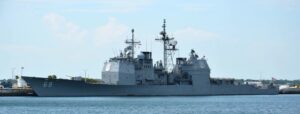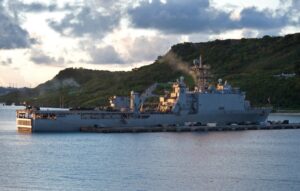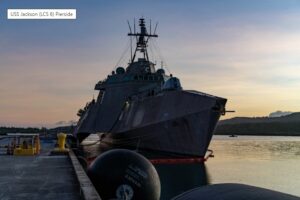Top Navy leaders recently argued in favor of decommissioning almost a dozen ships as part of the fiscal year 2024 budget process, seeking to redirect funds from those needing significant maintenance and repairs toward buying new vessels.
“If you want to reduce maintenance delays in the Navy to get the most bang for the bucks for the American taxpayer? Well then get rid of those old ships and who’s sitting in shipyards for upward of three and four years. They’re old, folks! As you open them up, you discover even more problem sets with them. They’re very close to their extended service life,” Secretary of the Navy Carlos Del Toro said during the annual McAleese Defense programs conference on March 15.
Particularly focusing on older
Whidbey Island/Harpers Ferry-class dock landing ships (LSDs), Del Toro said they are accruing high repair costs and timelines earlier than expected because “we’ve operated the living hell out of these ships, proudly so. It’s time to divest of them, so we could get more out of the investment of the American taxpayer and buy newer ships for the amphibious fleet, which is where I want to go in the future.”

Del Toro also said he wants to be allowed to decommission some of the older Ticonderoga-class cruisers “so we can actually invest more money in [Arleigh Burke-class DDG-51 destroyer] Fight IIIs, for example…so that we can get more of those out there and get more [Constellation-class] frigates out in the future as well too. And so that’s the sort of the trade space that we work in.”
The Navy’s FY ‘24 budget request, published last week, is looking to divest eight ships earlier than their expected service life (Defense Daily, March 13).
This includes the cruisers USS Cowpens (CG-63), Shiloh (CG-67), and Vicksburg (CG-69), which would be two, three and three years earlier than expected, respectively; the four dock landing ships USS Germantown (LSD-42), USS Gunston Hall (LSD-44), and USS Tortuga (LSD-46), which would be two to six years earlier than planned; and the Independence-class Littoral Combat Ships USS Jackson (LCS-6) and Montgomery (LCS-8).
During the Navy’s press briefing on its FY ‘24 budget request, Deputy Assistant Secretary of the Navy for Budget Rear Adm. John Gumbleton said the budget seeks to retire 11 ships total, with those eight listed as before their end-of-service-life.
“For the cruisers and LSDs, the decision to request this divestment was based on material condition, life remaining, cost and then time to upgrade. And then, of course, the resultant warfighting value,” Gumbleton said.
He argued the six cruisers and LSDs did not pass the return on investment analysis.
“In addition to the time and money saved with this divestment, we will also free up over 1,500 sailors to support higher-priority efforts.”
Gumbleton admitted for the two LCSs “there’s clearly life remaining. The decision here was based on resetting the Mine Countermeasures requirements at 15 vessels.”
Naval Sea Systems Command chief Vice Adm. Bill Galinis, also speaking at the McAleese event, said the cruiser modification program did not proceed as smoothly as intended.
“The cruiser mod program, we had kind of one vision now that’d play out. There were a number of factors that kind of led into how the strategy was developed. But I will tell you that the ones that are in the yard right now, the cruisers are just I’ll say a little bit long in the tooth. We know how to modernize combat systems, we know how to modernize C4I systems, even the [hull, mechanical and engineering] systems. But what we’re seeing on the cruisers right now is really just the infrastructure of the ship. It’s the hull, it’s the deck house, it’s the structural members of the ship. That’s really where the challenge is,” Galinis said.

“We’re not going to get the return on investment if we were to do all the work that we need to do on those ships, and make them combat relevant for the force going forward,” he continued.
Galinis also argued the older LCSs’ armament and combat capability “just don’t support the high end fight that we’re getting ready for right now. And so again, look at it really from a combat capability perspective and that’s what we’re kind of looking with why those ships should probably come out of service.”
Chief of Naval Operations Adm. Mike Gilday also reiterated the Navy’s approach to divest older ships that are not worth maintaining for a few more years to invest in better systems and platforms.
“So one of the things we have to get real about – instead of talking about estimated service lives, talking about actual service life,” Gilday said.
He used the example of a 34-35 year old unspecified LSD amphibious ship at a shipyard in Norfolk, Va.
While on average repair yard work is currently split into about five percent new work and 16 percent growth work across Navy shipyards, this specific ship has new work at 68 percent.
“So she is four years behind the shipyard. She’s costing us millions more than we need. We have to make tough decisions here. That’s money that we could pivot somewhere else,” Gilday said.
He said the Navy also needs to be more innovative with the ships they have, citing the example of experimenting with using some of the Spearhead-class expeditionary fast transport ships (EPF) for Marine Corps experimentation and transportation. The Navy sought 10 EPFs, but Congress has funded 16 vessels.
“Ships need to be workable, and they need to be usable. So those ships that aren’t either usable or workable, I might be able to replace those with something that’s a little bit more agile, we may have to use these a little bit differently. I get back to driving adaptability, effecting change. That’s how we need to think as well in the Navy, we can’t be so wedded to the way we’ve always done things,” Gilday said.
When asked how much it would cost to keep the Germantown, Gunston Hall and Tortuga usable in the fleet, Gilday did not have a specific figure at hand, but said it was a “substantial” amount.
“So it’s almost like a rolling average. Every year, there’s a new check that you got to write on a ship. One of them that should have been out of the yards in 2019 that we’ve still been forced to keep and we’re still writing checks on,” Gilday said.
The CNO said the Navy’s entering arguments for divestments is its top line budget figure, reiterating Gumbleton’s statement of divestment based on a return on investment analysis.
“We’re only going to have a Navy as big as we can afford. And so then what we do is we stratify all of our platforms, in terms of lethality. And that’s also informed by sustainability, what it’s going to cost to keep those ships as well as reliability,” he said.

Gilday argued this is all the more pressing because unspecified cruisers have had to pull into ports for structural repairs in recent times.
“For cruisers, as an example, I’m pulling them into Souda Bay, Crete or I’m pulling them into Djibouti during deployment to fix holes in the ship below the waterline. I got water going into berthing compartments, so those are considerations as well.”
However, the CNO said the main driver determining divestment choices is lethality to measure against the “pacing challenge” of China.
The Navy proposes decommissioning ships to Congress by putting the least lethal platforms on the table, Gilday said. However, he said while he understands congressional disagreements on that, some ships are not worth retaining given his priority on readiness for the forces the Navy has now.
“The friction with Congress is capacity in the repair yards and I get that, but you know, just having visited a repair yard with a cruiser that’s undergoing modernization, as well as an older amphib, they are not making money on those ships. So, and they are not lethal, we’re not going to get them underway for the fight. So my proposal is like let’s reinvest in something that is going to be lethal, and it is going to put us in a position of advantage against the pacing threat.. That’s not always met well, but you know, I have other ships waiting to go into maintenance,” the CNO said.
“Our operations and maintenance account is increasing next year to buy even more availabilities for our ships. Why? Because readiness is the number one priority,” he added.